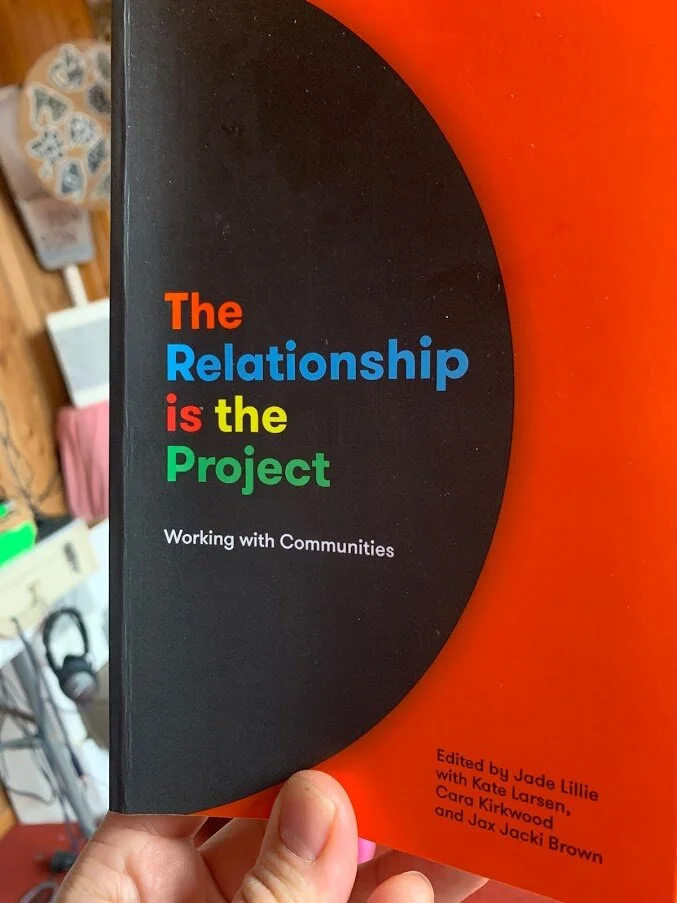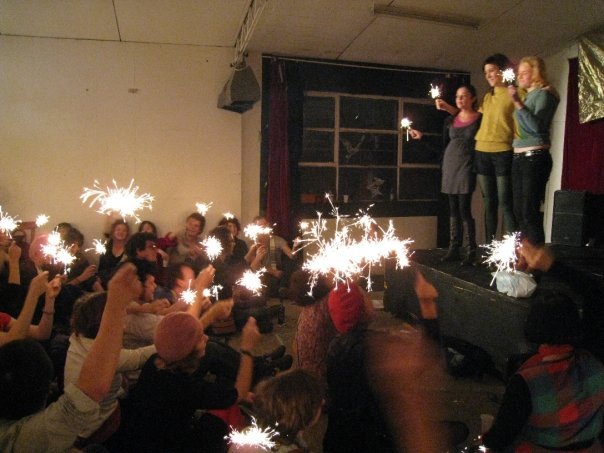Interactive Websites
PLAYABLEWEB.COM is our very own interactive website where we are experimenting with art created by kids!
There are heaps of other playful interactive websites out there, here are a few (click on the screenshot to go to the site), please let us know if you’ve seen a great interactive website out there!
Cat Bounce
Bounce a cat or two!
The Relationship is the Project
The Relationship is the Project Book Report
This is THE handbook for creating work with communities, a must-read for anyone working in this space. It is also just full of great writers that exemplify Australia’s socially engaged practice and offer a vision of how creative practice could and should be led.
CHAPTER 1 - First Peoples First
This is the first chapter of a book I have been excited to read for a long time.
This chapter was laid out simply ways that a First People’s ally can start to think about how to work in community without being patronising or paternalistic.
“Things to keep in mind"
Know yourself and your culture. What beliefs/practices are you bringing into this work? Understand your own culture and cultural practice. If applicable, recognise your white privilege and how your whiteness operates internally and externally.
Understand the unique history and culture of place. Each First Peoples community is different. Spend time learning and understanding the local context.
Work yourself out of a job. Create opportunities to strengthen and support local mob to take over your position.
Don't think you know best. Communities have the answers to their own problems.
Learn from the past. Listen and learn about what has gone before. Support community aspirations and existing projects rather than reinventing the wheel.
Do not speak for First Peoples. Always know your place as a supporter and an ally, not as a leader in the space.
Make a long-term commitment. The longer you work with a community, the greater your understanding and the more effective you will be.
Take time to build trust. Communities have experienced many workers come and go, with a range of positive and negative experiences. There have also been many disappointments due to broken promises and policy failures. Take the time you need to prove your worth.
CHAPTER 2 - Intersectionality
Kimberlé Williams Crenshaw
This chapter by Alia Gabres takes the term ‘intersectionality’ coined by Black Feminist writer Kimberlé Williams Crenshaw and relates it to arts practice and institutions.
It shows how some identities are marginalised
This includes those not thought of as ’mythically normal’
Identities can overlap to multiply discriminations (ie being disabled and black)
Self-awareness of privilege is a recurring theme so far in this book.
Dr. Lilla Watson
Ends with a great quote from Aboriginal Artist and Activist Dr Lilla Watson:
If you have come here to help me, you are wasting your time. But if you have come because your liberation is bound up with mine, let us work together
Chapter 3 - The Art of Collaboration
Like the title of the book declares The Relationship is the Project and this chapter outlines how collaboration is a kind of relationship. As in any good relationship three factors are key: Trust (ethical behaviour by all parties), language (how we talk about each other in the collaboration) and time (time is the key for establishing the other two factors, it is also often undervalued).
In this chapter Eleanor Jackson discusses the importance of being vulnerable and letting go of control, acknowledging power imbalances and being honest about yourself and your collaborators.
Chapter 4 - Ethics and Self-Determination
This Chapter by Tania Cañas describes the difference between Self-expression and Self-determination, and how it relates to collaborations between communities and artists.
the ever-continuing struggle to seize back their creative initiative in history through a real control of all the means of communal self-definition in time and space
- Ngũgi wa Thiong
This chapter made me think of the topic of black tokenism brought up briefly by the character playing Margaret Sloan-Hunter in the tv show Mrs. America. It is not enough to represent community using the privilege that we enjoy. We must strive to develop the opportunity for self-determination and true autonomy.
Chapter 5 - Access and Inclusion
I was lucky enough to be part of a workshop that Caroline Bowditch held for Polyglot Artists at the Abbotsford Convent in February this year. It was a great experience and it was equally great to read this chapter on access and inclusion in the arts.
Caroline outlines Social Model thinking that recognises people are disabled by barriers that society creates not by their condition or impairment.
Dissability results from an interaction between a non-inclusive society and an individual.
-United Nations
A remedy for the injustice that is disregard for the needs of a great number of the population may be found in universal design principles.
Ron Mace
Universal design is the design of products and environments to be usable by all people, to the greatest extent possible, without the need for adaptation or specialised design.
- Ron Mace
More about universal design can be found here: Centre for Universal Design Australia
Chapter 6 - Creating Communities
Chapter 7 - Creatively and Culturally Safe Spaces
Lia Pa’apa’a
Chapter 8 - Platforming for Community: Going beyond surface representation
Adolfo Aranjuez
Chapter 8 - Cultural Safety: An overview
Ruth De Souza and Robyn Higgins
This chapter gives an overview of cultural safety and how it can apply to arts institutions and arts practice. The practice of cultural safety education comes from advocacy by Māori nurses. It was taken up by the New Zealand nurses association and asks people to examine their inherent cultural biases and how they might affect their practice.
This chapter also highlights the Australia Council statistics that highlight the inequity in the Australian Arts industry. The principles of cultural safety include critical self-reflection, engaged communication, minimising power imbalances and decolonising practice. Through a lifelong commitment to these principles, we can get onto the road of a more equitable arts landscape.
Interpersonal Touch Musical Interfaces
Collecting some of the experiments in the field of interpersonal touch based musical interfaces.
Sound and Cardboard
Working with motors, string, paper and cardboard Swiss artist Zimoun makes amazing installations that dramatically change spaces both sonically and visually.
www.zimoun.net
Colouring in Kingston
I came across this project today called Colouring in Kingston. It has been created by Kingston School of Arts students Izzi Toovey and Josephine Miller. They are digitally recolouring childrens’ drawings and presenting them on Instagram.
It is especially interesting as I am seeking ways of collaborating with participants in this post COVID world. Playable Streets has created Playable Web as a platform for somewhat similar collaborations. Kidstruments and Exquisite Stories are two works that we are currently presenting based on works that had been developed pre-COVID.
One thing that we have found has been the most tricky part of these collaborations are the instructions! Here are the instructions for Colouring in Kingston. They are clear but quite a large document.
It will be interesting to see how this sort of collaboration evolves and develops in the future.
A picture by 10 year old Josh (right), and the digitally coloured version created as part of Colouring in Kingston.
The images are being used to create posters for Kingston Council to ‘spread messages of health, wellbeing and our environment’
Playtronica - Touch interfaces and performance
The Russian / French company Playtronica is definitely the most prolific creators of touch-based musical installations. They currently have two devices that they sell that allow anyone to create the kind of work that they put into public spaces (or perform in concert settings).
This blog post will grow over time as I develop a greater understanding of their work and look at examples of their performances and novel uses of their devices (Touch Me and Playtron).
Playtronica at the Pompidou
Playtronica created this performance piece in collaboration with Arte Radio at the Centre Pompidou. It is a re-imagining of György Ligeti’s music and inspired by the Endless Column sculpture b y Constantin Brâncuși in the background.
The passers-by had to, step onto Playtronica-wired floor, and touch the skin of the “columns”. Thus, by spontaneous interaction of strangers, a new interpretation of a famous masterpiece was born.
‘Inclusive’ testing of their installation at the Pompidou
They Say / I Say
PREFACE
They Say / I Say by Gerald Graff and Cathy Birkenstein
Just starting this book and I can see how useful it will be as I begin my writing for this PhD. It Suggests a series of templates can be the way to open up academic writing and show it’s workings (without making it formulaic).
Basically, I have to summarise the “They Say” to set up my argument (“I Say”)
Check out the They Say I Say blog HERE
Some Logical principles of argument not covered in the book (but worth an investigation)
Syllogisms: An argument that arrives at a conclusion based on two or more propositions :
“All men are mortal. Socrates is a man. Therefore, Socrates is mortal.”
Warrants: The reason the evidence supports a claim. Or the reason the evidence is trustworthy and therefore your argument is built on a solid foundation of fact.
Logical Fallacies: Basically this is errors in the facts. They can be spotted due to a lack of evidence or misuse of statistics for example. Just think of Donald Trumps’ use of coronavirus statistics.
Inductive Reasoning: This starts with facts and works it’s way to a conclusion through more of an explorative process. It may be a way to generate a hypothesis from a series of facts rather than using those facts to prove a hypothesis.
Deductive Reasoning: Starts with a theory or hypothesis and works its way towards a conclusion based on evidence. For example, my hypothesis is that technology can be used to create engaging interactive experiences. If I can provide examples and evidence that supports this I can deduce (Mr Watson) that technology indeed can be used to create engaging interactive experiences.
'Touch': A panel discussion about the use of touch in performance, led by Jane McLean, Ruth Spencer and Laura Blake
A panel discussion about the use of touch in performance, led by Jane McLean, Ruth Spencer and Laura Blake.
I particularly found the work of Laura Blake interesting for my research on touch interaction and accessibility.
Laura Blake:
Visual Artist creating work that can be touched and interacted with.
Co-design is part of her practice, audiences test ideas around works.
Works with neurodiverse audiences.
It’s important they have the experience they want to have with it.
“Objects become a tool for communication between people.”
THE SOCIALLY DISTANCE FUTURE OF TOUCH:
Do we need to think about changing the art materials?
Continue to advocate for touch, don’t forget about it.
Touch language of the supporting adult is very important.
Artwork by Laura Blake
Artwork by Laura Blake
Oily Cart Interview with Joanna Grace
Joanna Grace is an artist, academic and writer creating work and writings about people with profound and multiple learning disabilities.
Some of the issues discussed:
Creating sensory theatre for multiple layers of work for people of all intelects.
Talks about vestibular sense stimulation ie moving through space as a participant.
Peri Hand space is an extra sensory ‘helper’
“Shutting up can be a powerful thing”
Talked about sensory rooms and ways they can be successful or unsuccessfull
Sensory Being for Sensory Beings by Joanna Grace
Inspiration, musings and cool stuff from the world of music, technology, art, design and probably other random stuff!
































